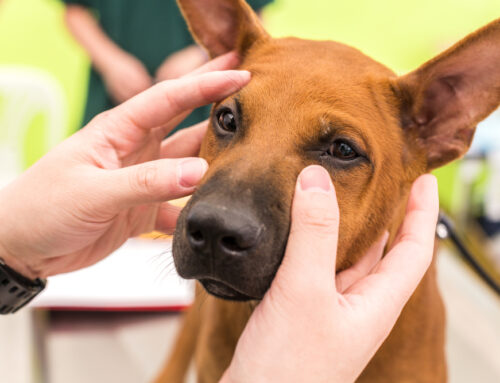Similar to people, pets who live long enough are likely to develop some degree of degenerative joint disease (i.e., arthritis, or osteoarthritis). This progressive condition impacts joint health and function, causing pain, inflammation, and reduced mobility. Untreated arthritis can negatively affect pets’ quality of life, but veterinary and at-home interventions can usually reduce discomfort and slow down disease. The Central Kentucky Veterinary Center team wants to educate pet owners about arthritis signs they should watch for at home and treatment options that can help.
Arthritis: What is it and what causes it in pets?
Arthritis is a degenerative and progressive condition that causes inflammation inside joints. The inciting cause is poorly understood, but arthritis is thought to begin with cartilage damage that sends out chemical mediators, which start the inflammatory process and, in turn, worsen the cartilage damage. Eventually, inflammation erodes the normal joint structures, leading to instability and pain. Dogs and cats will favor their painful joints, causing muscle atrophy, weakness, immobility, and worsening pain. This cycle will continue to destroy affected joints until medical treatments intervene.
Arthritis can impact any pet and any joint, but most often attacks the knees, hips, shoulder, spine, and elbows. Arthritis risk factors include:
- Older age
- Developmental joint issues (e.g., hip dysplasia)
- Previous joint injury
- Obesity
Arthritis: Recognizing the disease in dogs and cats
Arthritic pets may show only subtle signs when they first feel pain, but you will notice more obvious changes as their pain becomes worse. Signs to look for in dogs include:
- Limping or weight-shifting
- Stiffness after rest
- Difficulty with jumping or stairs
- Slipping or falling on hard surfaces
- Soreness after heavy activity
Signs in cats are easier to miss than in dogs. Cats may limp or show stiffness like dogs but also show other signs, including:
- Reduced grooming
- No longer curling tightly to sleep
- Hesitancy to jump up or down
- Hesitancy or change in ability to use stairs
- Accidents outside the litter box
- Irritability
- Hiding
Arthritis: How veterinarians diagnose pets
Schedule a veterinary visit if you notice any arthritis signs in your pet. Our veterinary team will perform a complete physical examination, which may reveal arthritis signs, such as joint swelling, instability, stiffness, crackling (i.e., crepitus), pain, or reduced range of motion. To rule out other disease processes with similar signs, we may order X-rays, blood work, or joint fluid analysis.
Pet owners can easily miss their pet’s early arthritis signs at home, but our veterinary team will often detect signs during routine wellness examinations—one of many reasons your pet should receive annual preventive care. We may also “incidentally” diagnose arthritis on an X-ray taken for another reason, such as measuring heart size or working up a gastrointestinal problem.
Arthritis: Treatment options for pets
Many different arthritis treatments are available for dogs and cats. The best is a multimodal approach that combines several different treatment options for a synergistic effect. The options we choose or recommend for your four-legged friend will depend on their overall health and condition severity. Possible treatments include:
- Oral pain and anti-inflammatory medications
- Long-acting injectable pain medications
- Joint health supplements
- Cartilage protectant injections
- Rehabilitation therapies
- Alternative therapies (i.e., chiropractic, acupuncture, laser)
- Regenerative medicine (i.e., stem cell therapy, platelet-rich plasma)
- Surgery
- Prescription therapeutic diet
- Omega-3 fatty acids
Arthritis: Helping pets cope

In addition to the medical treatments our team recommends, you can help improve your pet’s condition and quality of life with changes at home, such as adding rugs for traction and making bedding, litter boxes, and other necessities more easily accessible to your pet’s main hang-out areas. Next, consider lifestyle changes that may help reduce pain and improve mobility, such as:
- Exercise — Take frequent, low-intensity walks with your dog, or encourage your cat to move through play. Movement helps lubricate joints and reduces stiffness.
- Diet — Keep your pet’s weight on the lean side through proper nutrition—ask our team for recommendations.
Arthritis is extremely common in dogs and cats and can significantly impact their quality of life. Help arthritic pets cope by recognizing the signs at home, visiting the Central Kentucky Veterinary Center team, and choosing treatment options that fit your and your furry pal’s needs. Call us to schedule an appointment or learn more about the advanced arthritis treatments we offer that will improve your pet’s wellbeing.







Leave A Comment